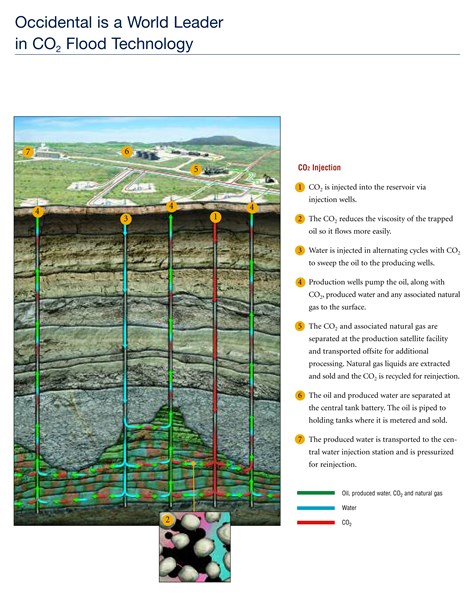LOS ANGELES, Feb. 10, 2006 (PRIMEZONE) -- Occidental Petroleum Corporation (NYSE:OXY) announced today that the company is in discussions with BP (NYSE:BP) to develop options for sequestering carbon dioxide (CO2) in its California oil fields. The CO2 would be captured as a byproduct from the 500 MW hydrogen-fired power project proposed to be constructed in Carson, California as a joint venture between BP and Edison Mission Group, a unit of Edison International (NYSE:EIX). Removing the CO2, a greenhouse gas, from the energy generation process would make this one of the world's cleanest power generation plants.
The captured CO2 is expected to have the added benefit of enhancing oil recovery from California's mature oil fields. Occidental, the world's largest CO2 operator, is successfully injecting more than one billion cubic feet of CO2 per day in its Permian Basin oil production operations in West Texas and New Mexico. The application of this technology is responsible for approximately 85,000 barrels per day of Occidental's current oil production in the Permian Basin from previously unrecoverable reserves. Technical studies are underway to determine which of Occidental's California oil fields would most benefit from CO2 flooding technology.
Occidental currently operates the giant Elk Hills field in California's southern San Joaquin Valley, the THUMS operation in Long Beach and other properties in the Sacramento Valley in northern California. These properties accounted for total production, net to Occidental, of approximately 120,000 barrels of oil equivalent per day in the fourth quarter 2005.
CO2 flooding is a proven enhanced oil recovery technique in which the CO2 is injected deep into oil reservoirs with minimal environmental impact to reduce the viscosity of the trapped oil so it flows more easily to the well bores, increasing production and extending the economic life of mature oil fields. The CO2 is produced along with the recovered oil, then recycled and reinjected. Upon completion of the project, the CO2 would be permanently stored, or geologically sequestered, in the reservoir. CO2 injection is a tertiary (third) recovery method applied in mature oil fields after primary methods have run their course.
A graphic depicting CO2 flooding technology is available at: http://media.primezone.com/cache/3/file/2684.html
Statements in this press release that contain words such as "will," "expect" or "estimate," or otherwise relate to the future, are forward-looking and involve risks and uncertainties that could significantly affect expected results. Factors that could cause results to differ materially include, but are not limited to: exploration risks such as drilling of unsuccessful wells, global commodity pricing fluctuations and supply/demand considerations for oil, gas and chemicals; higher than expected costs; political risks; changes in tax rates; unrealized acquisition benefits or higher than expected integration costs; and not successfully completing (or any material delay in) any expansion, capital expenditure, acquisition or disposition. Such forward-looking statements speak only as of the date of issuance. Unless legally required, Occidental does not undertake any obligation to update any forward-looking statements as a result of new information, future events or otherwise. U.S investors are urged to consider carefully the disclosure in our Form 10-K, available at www.oxy.com. You also can obtain a copy from the SEC by calling 1-800-SEC-0330.
